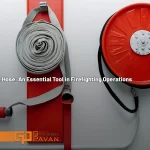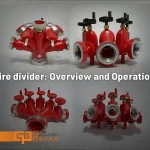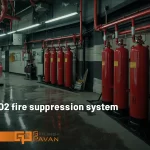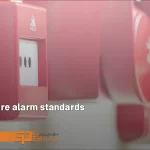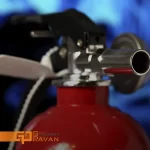Sprinkler systems are often the most common solution to protect people and property from fire hazards. Although water-based sprinklers have many advantages, their environmental degradation rate is also high. For this reason, sometimes when there is a need to quickly suppress a fire and protect sensitive items of high value, a Clean Agent fire suppression system is the best choice. In this article from Ganjineh Pavan’s articles, we will examine these fire suppression systems and the NFPA 2001 standard that is related to them.
What is a Clean Agent fire suppression system?
As defined by the National Fire Protection Association (NFPA), a “clean agent” is a gaseous fire extinguisher that is electrically non-conductive and leaves no residue after vaporization. It is ideal for protecting high-value items such as historical documents, antiques, or sensitive electronic equipment.
In general, the term “clean agent” includes halocarbon agents and inert gases. Carbon dioxide (CO2) is another extinguishing agent with all the properties of a clean agent, but is often classified differently due to the hazards associated with it.
So, a clean agent fire extinguishing system uses a chemical gas or inert gas to suppress the fire in the initial stage before it grows and is very effective in extinguishing Class A, B, and C fires.
Clean agent fire suppression systems are safe for use in spaces containing sensitive materials. They do not need to be cleaned after discharge and are environmentally friendly with a short, non-atmospheric life and low global warming potential (GWP). These systems are designed to protect small, closed areas or entire rooms containing documents or sensitive equipment.
Types of clean agent fire extinguishing systems
The most common types of chemical-free extinguishing systems use chemical agents such as FM-200 (HFC-227ea) and 3M™ Novec™ 1230 Fire Protection. Fluid or inert gases such as nitrogen, argon, and carbon dioxide have been formed.
All clean materials are stored as gas or liquid, and when the system is activated, it releases the cleaning agent as a gas to contain the fire. Once discharged, the purge agent removes or disrupts one of the three elements needed to sustain a fire—heat, oxygen, or a fuel source. Most clean agent fire suppression systems reach extinguishment levels in only 10 seconds or less. Which makes them very efficient in controlling fire before significant damage is done. Because the cleaning material evaporates quickly, there is minimal downtime because no cleaning is required.

Advantages and disadvantages of different clean agents
When it comes to clean agent fire extinguishing system costs, 3M Novec 1230 and FM-200 fluids are more economical than other gas systems. Because it requires less fire suppression agent and requires smaller storage cylinders. Comparing 3M Novec 1230 and FM-200 fluid, 3M Novec 1230 fluid is slightly more expensive.
Among the three clean agents, inert gas is the most environmentally friendly, with zero ozone depletion potential (OPD) and zero GWP. While both 3M Novec 1230 and FM-200TM fluids have zero ODP, 3M Novec 1230 fluid is more environmentally friendly due to its lower GWP of 1.
How do these systems work?
For example, if a room contains a large amount of electronics, a water-based fire protection system may prevent them from being damaged by fire. However, all electronics are still subject to water damage. Buildings with large data servers, museums, storage warehouses, gas stations, grills, and fryers require specialized systems to contain fires without damaging items or complicating the situation.
Clean agent fire suppression systems are a safe and efficient alternative that provide a way to protect valuables and extinguish fires caused by certain elements. These systems use gases that are less dangerous for humans.
Clean agent fire extinguishing systems are specifically designed for high-traffic areas that contain delicate items. In addition, these systems automatically detect fire and start extinguishing it.
Applications of clean agent systems
Some of the common applications and zones protected by the clean agent suppression system are:
- CNC and EDM machines
- Cabinet and switchboard
- Components inside the nacelle of a wind turbine
- Data storage and telecommunication systems
- Recording/file repositories and libraries
- Museums, works of art, and other important cultural assets

What is the best clean agent fire suppression system?
When it comes to evaluating a clean agent fire suppression system, there are several factors to consider. You should consider the area or type of equipment you are protecting, the amount of space required for the clean agent cylinders, and the location of the cylinders relative to the area or property that is protected.
As previously mentioned, inert gases are less effective than chemical agents and require more agents, requiring larger or more cylinders to protect the same space.
Inert gas systems can be located further away from the protected space due to the pressure of each cylinder and the easier flow of inert gas through the discharge pipes.
FM-200 and 3M Novec 1230 fluid systems must be located adjacent to the protected area. Because compressed liquids and inert gases do not flow and need a smaller distance between the cylinder and the discharge pipes.
NFPA 2001 Standard for Clean Agent Fire Suppression Systems
The Halon Alternative Protection Options Technical Committee was organized in 1991 and immediately began work to address the new flood clean-up agents being developed to replace Halon 1301. Due to its harmfulness, the use of halon in fire extinguishing systems was banned in 1995.
New clean agents and the NFPA 2001 standard were established to meet the requirements related to environmental indicators.
The NFPA 2001 standard examines the design, installation, and all requirements related to clean agent fire extinguishing systems.
The 1994 edition was the first edition of NFPA 2001. This standard was revised in 1996, 2000, and again in 2004.

Some requirements of the NFPA 2001 Standard
1.4 General information
1.4.1* Ability to use agents
1.4.1.1 The fire extinguishing agents mentioned in this standard must be electrically non-conductive and not leave any traces during evaporation.
1.4.1.3 The design, installation, service, and maintenance of clean operating systems should be done by people who are experts in the technology of fire extinguishing systems with clean operating systems.
1.4.2 Use and Limitations
1.4.2.1 All pre-engineered systems shall be installed to protect against hazards within the limits specified by the list. Pre-engineered systems should be listed as one of the following types:
(1) Those consisting of system components designed for installation based on pre-tested limits by the testing laboratory. These pre-engineered systems shall allow for special nozzle combinations, flow rates, application methods, nozzle placement, and pressure levels that may differ from those described elsewhere in this standard. All other requirements of the standard shall apply.
(2) Automatic extinguishing units including special nozzles, flow rates, application methods, nozzle placement, actuation techniques, piping materials, discharge times, installation techniques, and pressure levels that may be inconsistent with those contained elsewhere in this standard, be different.
1.4.2.2 Clean agents should not be used in fires involving the following materials. Unless the agents have been tested with the consent of the legal authority:
(1) Certain chemicals or mixtures of chemicals, such as cellulose nitrate and gunpowder, are capable of rapid oxidation in the absence of air.
(2) active metals such as lithium, sodium, potassium, magnesium, titanium, zirconium, uranium, and plutonium
(3) Metal hydrides
(4) Chemicals are capable of autothermal decomposition, such as certain organic peroxides, pyrophoric substances, and hydrazine.
1.4.2.3 Where a complete flooding system is used, a fixed enclosure shall be provided on the hazard that allows a specified agent concentration to be achieved and maintained for a specified period.
1.4.2.4 The effects of agent decomposition on the effectiveness of fire protection and equipment should be considered where clean agents are used in high ambient temperature hazards (e.g., furnaces and ovens).
The last word of the clean agent fire suppression system
A clean agent fire extinguishing system is suitable for places containing sensitive materials or tools. Because these materials are ineffective, they do not have a destructive effect on the materials, and after the system is activated, there is no need to clean the environment.
Design, installation, and maintenance of clean agent fire extinguishing systems should be done according to NFPA 2001 standards.
Ganjineh Pavan Company, relying on the expertise and experience of its elite personnel, provides consulting services, supply, and implementation of fire alarm and extinguishing projects at different levels.
To get a free consultation, please refer to our contact page on the Ganjineh Pavan website.
Sources:


